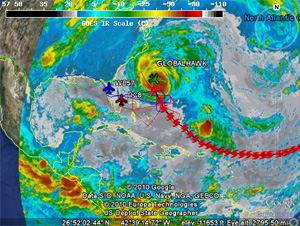
The Genesis and Rapid Intensification Processes (GRIP) experiment was a NASA Earth science field experiment in 2010 that was conducted to better understand how tropical storms form and develop into major hurricanes. NASA used the DC-8 aircraft, the WB-57 aircraft, and the Global Hawk Unmanned Airborne System (UAS) configured with a suite of in situ and remote sensing instruments used to observe and characterize the lifecycle of hurricanes.

 The GRIP deployment was 15 August – 30 September 2010 with bases in Ft. Lauderdale, FL for the DC-8, at Houston, TX for the WB-57, and at NASA Dryden Flight Research Facility, CA for the Global Hawk. This campaign capitalized on a number of ground networks, airborne science platforms (both manned and unmanned), and space-based assets. The field campaign was executed according to a prioritized set of scientific objectives. In two separate science solicitations, NASA selected a team of investigators to collect NASA satellite and aircraft field campaign data with the goal of conducting basic research on problems related to the formation and intensification of hurricanes.
The GRIP deployment was 15 August – 30 September 2010 with bases in Ft. Lauderdale, FL for the DC-8, at Houston, TX for the WB-57, and at NASA Dryden Flight Research Facility, CA for the Global Hawk. This campaign capitalized on a number of ground networks, airborne science platforms (both manned and unmanned), and space-based assets. The field campaign was executed according to a prioritized set of scientific objectives. In two separate science solicitations, NASA selected a team of investigators to collect NASA satellite and aircraft field campaign data with the goal of conducting basic research on problems related to the formation and intensification of hurricanes.
The spaceborne and airborne observational capabilities of NASA put it in a unique position to assist the hurricane research community in addressing shortcomings in the current state of the science. The relatively recent launch of several new satellites, the prospect of using a high-altitude UAS for hurricane surveillance, and the emergence of new remote sensing technologies offered new research tools that needed to be explored and validated. Of great importance were new remote sensing instruments for wind and temperature that can lead to improved characterization of storm structure and environment.
The GRIP hurricane field campaign and research project were managed by Dr. Ramesh Kakar, Weather Focus Area Leader within the Earth Science Division, NASA Headquarters in Washington, D.C. Dr. Kakar was primarily responsible for assembling the science team and the instrument payload for the NASA aircraft participating in this field experiment.
DOI:
http://dx.doi.org/10.5067/GRIP/DATA101






